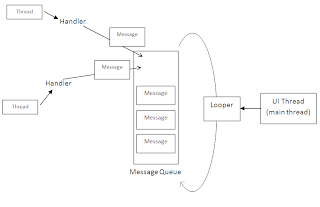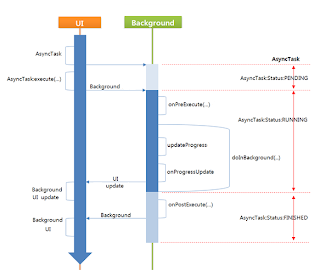INTRODUCTION :
As explained in last post, When an application is launched, A new process created to host it with its own Darvik VM instance, application also gets single thread knows as UI/Main thread,(thread responsible for UI display or update)
CONCEPT :
In almost every OS, for UI updating, there is a UI thread, which runs an infinite loop and checks a queue to see if there are any pending UI events.
In case of Android, above concept is implemented with help of :
1. Looper
MessageQueue4. Handler
The looper loops over a
MessageQueue which contains the messages to be dispatched. The actual task of managing the queue is done by a Handler which is responsible for handling (adding, removing, dispatching) messages in the message queue.
Looper and handler :
1. Looper can be associated only with one thread and association cannot be changed.
2. Mulitple handlers can be associated with a message queue.
3. Blocking operation on the UI thread leads to Application not responding(ANR) dialog.
Android Rule for updating UI :
1. Do not block the UI thread.
2. Do not access the Android UI toolkit from outside the UI thread.
For example :
Consider below example for updating UI from worker thread:
Above example violates the second android Rule for updating UI.This can result in undefined and unexpected behavior.
To fix this problem, Android offers:
1. Activity.runOnUiThread(Runnable)
2. View.post(Runnable)
3. View.postDelayed(Runnable, long)
Above problem can be fixed with below solution :
Android suggestion for handling above scenario :
1. Handler
2. AsyncTask
1. Handler :
Handler provide bridge for new threads to add messages to messages queue.
Other methods for accessing message queue :
handler.sendMessageAtFrontOfQueue()
handler.sendMessageAtTime()
handler.sendMessageDelayed()
handler.sendEmptyMessage()
Description :
Handler have handleMessage() which has msg argument, which is used for updating UI.
For sending msg to Handler, we can obtain message from Handler object and manipulate msg.obj and then send message to handler, which is handled by handleMessage() .
2. AsyncTask :
It’s a wrapper for a threaded operation, what all we did in above example.
Description:
Above line consist of 3 parameter for AsyncTask
1. Params : parameter passed to doInBackground(Integer... params)
2.Progress : parameter passed to onProgressUpdate(String... progress)
3.Result : parameter passed to onPostExecute(Long result)

doInBackground() :Code in this method is handled in a sperate thread. Note that the data type of the return value corresponds to the type third parameter in the class definition. Returned value from this method is passed to the onPostExecute() method when this thread completes.
Datatype passed corresponds to the first parameter in the class definition.
onProgressUpdate() :Report progress. datatype passed corresponds to the second parameter in the class definition. This callback can be triggered from within the body of the doInBackground() method by calling publishProgress()
onPostExecute() :This method is called when the thread has completed successfully. Note that the datatype passed to this parameter matches the third parameter in the method definition.
The AsyncTask class also provides helpful callback methods likeonCancelled() which handles the cancellation of the thread and onPreExecute() which is called just before the thread calls doInBackground().
